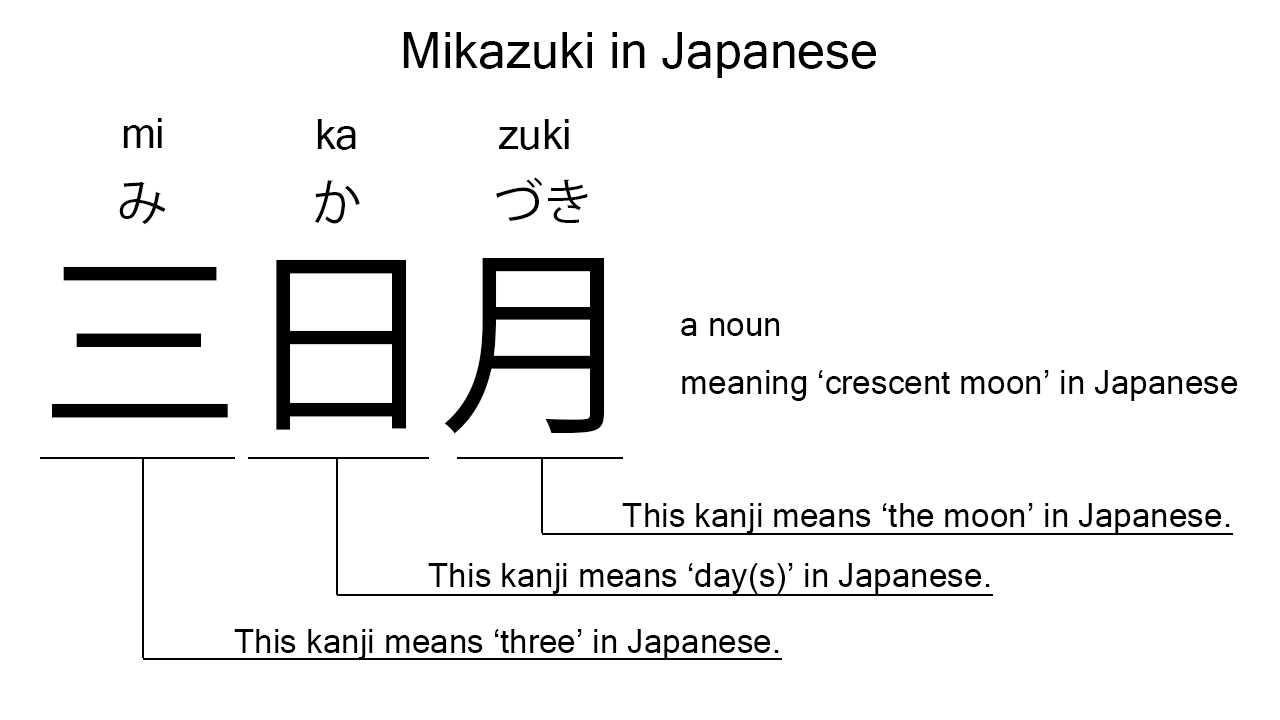What does “mikazuki” mean in Japanese?
Native speakers say “mikazuki” to mean ‘crescent moon’ in Japanese. Perhaps, some Japanese learners know this word as it is sometimes used in Japanese movies, songs, novels, manga, anime, and the like. In this blog post, however, I will explain it in detail based on its kanji expression. And also, I will explain how to use it through example sentences. My explanations would help Japanese learners to understand “mikazuki” more clearly. Then, let’s get started!
Contents
Definition and meaning of “mikazuki”
Let me start with the definition and meaning of “mikazuki”.
- mikazuki – 三日月 (みかづき) : a noun meaning ‘crescent moon’ in Japanese.
Japanese people often differentiate a crescent moon from the other phases of the moon. So, they say “mikazuki” to refer to the specific phase. Depending on the context and situation, however, it can also refer to other similar phases.
The definition and meaning of “mikazuki” are simple and clear, I think. To understand this noun more clearly, however, let me explain its kanji characters in detail, one by one.
Mikazuki in kanji
The kanji expression of “mikazuki” consists of the following three characters:
- 三 : a kanji character widely used as a numeral meaning ‘three’ in Japanese.
- 日 : a kanji character widely used to mean ‘day’ in Japanese.
- 月 : a kanji character widely used to mean ‘(the) moon’ in Japanese.
These three kanji characters tell us that “mikazuki” literally means ‘three day moon’ in Japanese. This literal interpretation is not completely in line with the meaning, but still very understandable. “Mikazuki” is widely considered as the three-day-old moon in Japan. This idea is strongly related to a lunar calendar which Japanese people used in the past.

When we meet new kanji expressions, we should check their kanji characters in detail to understand their meanings clearly and deeply. In many cases, kanji characters tell us a lot about the meanings of the expressions they form. Actually, here, we could get the better understanding of “mikazuki” through the detailed kanji check above.
So far, I’ve explained the definition and meaning of “mikazuki” together with its kanji expression. Then, let me explain how to use it through the example sentences below.
Example #1: how to say “crescent moon” in Japanese
kinou wa mikazuki ga kirei deshi ta – 昨日は三日月が綺麗でした (きのうはみかづきがきれいでした)
Yesterday, the crescent moon was beautiful.
Below are the new words used in the example sentence.
- kinou – 昨日 (きのう) : a noun meaning ‘yesterday’ in Japanese.
- wa – は : a binding particle working as a case marker or topic marker. In the example, this works as a topic marker after “kinou” to put a focus on it.
- ga – が : a case particle used to make the subject word or the object word in a sentence. In the example, this is used after “mikazuki” to make the subject in the sentence.
- kirei – 綺麗 (きれい) : the stem part of the na-adjective, “kireina“, which means ‘beautiful’ in Japanese.
- deshi – でし : one conjugation of the auxiliary verb, “desu”, which is used after a noun or adjective to make it polite.
- ta – た : an auxiliary verb used after a verb, adjective, or auxiliary verb to make its past tense form. In the example, this is used after “kirei deshi” to make its past tense form, “kirei deshi ta”.
This is a typical usage of “mikazuki”. When we want to say “crescent moon” in Japanese, this noun is a very good option.
Example #2: another usage of “mikazuki”
boku wa mikazuki no katachi ga suki desu – 僕は三日月の形が好きです (ぼくはみかづきのかたちがすきです)
I love the shape of a crescent moon.
Below are the new words used in the example sentence.
- boku – 僕 (ぼく) : a pronoun meaning ‘I’ in Japanese. This is used mainly by boys and young males.
- no – の : a case particle used to join two nouns. Normally, the first one can work as a modifier to describe the second. In the example, this is used to join “mikazuki” and “katachi”. The formed phrase literally means ‘the shape of a crescent moon’ in Japanese. Word orders in Japanese and English are different, but the role of this case particle is similar to that of the English preposition, “of”.
- katachi – 形 (かたち) : a noun meaning ‘shape’ in Japanese. This can also work as plural. Learn more about Japanese plural.
- suki – 好き (すき) : the stem part of the na-adjective, “sukina”, which means ‘favorite’ in Japanese. Native speakers, however, often use this as an individual word to mean ‘to like’ or ‘to love’. In the example, actually, this is used to mean ‘to love’ in Japanese.
- desu – です : an auxiliary verb used after a noun or adjective to make it polite. In the example, this is used after “suki” to make it sound polite.
This is another typical usage of “mikazuki”. In this example, it works as a part of the noun phrase, “mikazuki no katachi”, which means ‘the shape of a crescent moon’ in Japanese.
Summary
In this blog post, I’ve explained the definition and meaning of “mikazuki” in detail based on its kanji expression. And also, I’ve explained how to use it through the example sentences. Let me summarize them as follows.
- mikazuki – 三日月 (みかづき) : a noun meaning ‘crescent moon’ in Japanese. These three kanji characters literally mean ‘three day moon’ in Japanese. This literal interpretation is not completely in line with the meaning, but still very understandable. “Mikazuki” is widely considered as the three-day-old moon in Japan. This idea is strongly related to a lunar calendar which Japanese people used in the past.
Hope my explanations are understandable and helpful for Japanese learners.